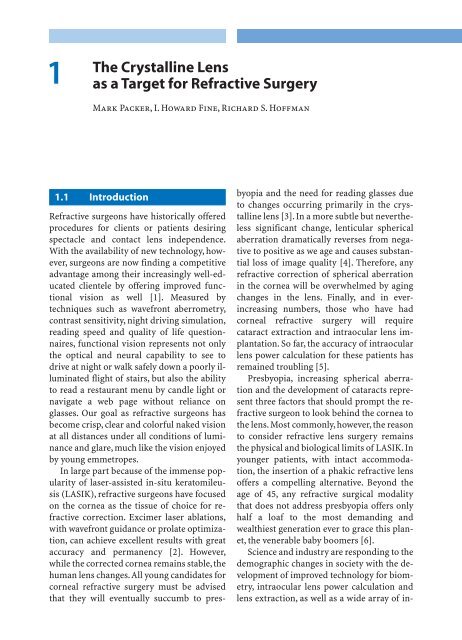Refractive Lens Surgery
Refractive Lens Surgery
Refractive Lens Surgery
You also want an ePaper? Increase the reach of your titles
YUMPU automatically turns print PDFs into web optimized ePapers that Google loves.
1<br />
The Crystalline <strong>Lens</strong><br />
as a Target for <strong>Refractive</strong> <strong>Surgery</strong><br />
Mark Packer, I. Howard Fine, Richard S. Hoffman<br />
1.1 Introduction<br />
<strong>Refractive</strong> surgeons have historically offered<br />
procedures for clients or patients desiring<br />
spectacle and contact lens independence.<br />
With the availability of new technology, however,<br />
surgeons are now finding a competitive<br />
advantage among their increasingly well-educated<br />
clientele by offering improved functional<br />
vision as well [1]. Measured by<br />
techniques such as wavefront aberrometry,<br />
contrast sensitivity, night driving simulation,<br />
reading speed and quality of life questionnaires,<br />
functional vision represents not only<br />
the optical and neural capability to see to<br />
drive at night or walk safely down a poorly illuminated<br />
flight of stairs, but also the ability<br />
to read a restaurant menu by candle light or<br />
navigate a web page without reliance on<br />
glasses. Our goal as refractive surgeons has<br />
become crisp, clear and colorful naked vision<br />
at all distances under all conditions of luminance<br />
and glare, much like the vision enjoyed<br />
by young emmetropes.<br />
In large part because of the immense popularity<br />
of laser-assisted in-situ keratomileusis<br />
(LASIK), refractive surgeons have focused<br />
on the cornea as the tissue of choice for refractive<br />
correction. Excimer laser ablations,<br />
with wavefront guidance or prolate optimization,<br />
can achieve excellent results with great<br />
accuracy and permanency [2]. However,<br />
while the corrected cornea remains stable,the<br />
human lens changes.All young candidates for<br />
corneal refractive surgery must be advised<br />
that they will eventually succumb to pres-<br />
byopia and the need for reading glasses due<br />
to changes occurring primarily in the crystalline<br />
lens [3]. In a more subtle but nevertheless<br />
significant change, lenticular spherical<br />
aberration dramatically reverses from negative<br />
to positive as we age and causes substantial<br />
loss of image quality [4]. Therefore, any<br />
refractive correction of spherical aberration<br />
in the cornea will be overwhelmed by aging<br />
changes in the lens. Finally, and in everincreasing<br />
numbers, those who have had<br />
corneal refractive surgery will require<br />
cataract extraction and intraocular lens implantation.<br />
So far, the accuracy of intraocular<br />
lens power calculation for these patients has<br />
remained troubling [5].<br />
Presbyopia, increasing spherical aberration<br />
and the development of cataracts represent<br />
three factors that should prompt the refractive<br />
surgeon to look behind the cornea to<br />
the lens. Most commonly, however, the reason<br />
to consider refractive lens surgery remains<br />
the physical and biological limits of LASIK. In<br />
younger patients, with intact accommodation,<br />
the insertion of a phakic refractive lens<br />
offers a compelling alternative. Beyond the<br />
age of 45, any refractive surgical modality<br />
that does not address presbyopia offers only<br />
half a loaf to the most demanding and<br />
wealthiest generation ever to grace this planet,<br />
the venerable baby boomers [6].<br />
Science and industry are responding to the<br />
demographic changes in society with the development<br />
of improved technology for biometry,<br />
intraocular lens power calculation and<br />
lens extraction, as well as a wide array of in-



